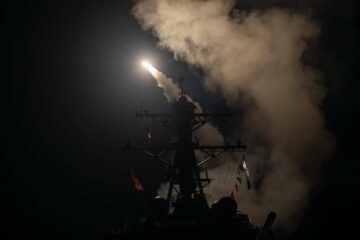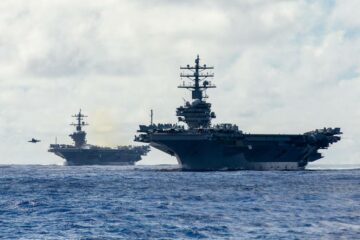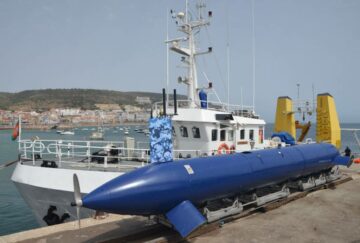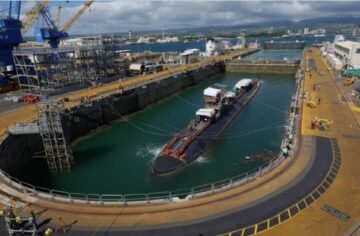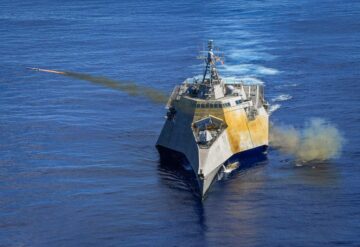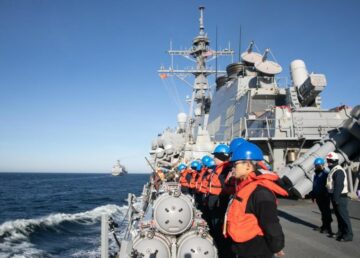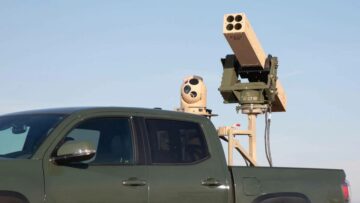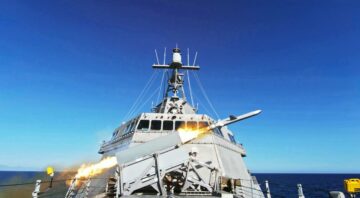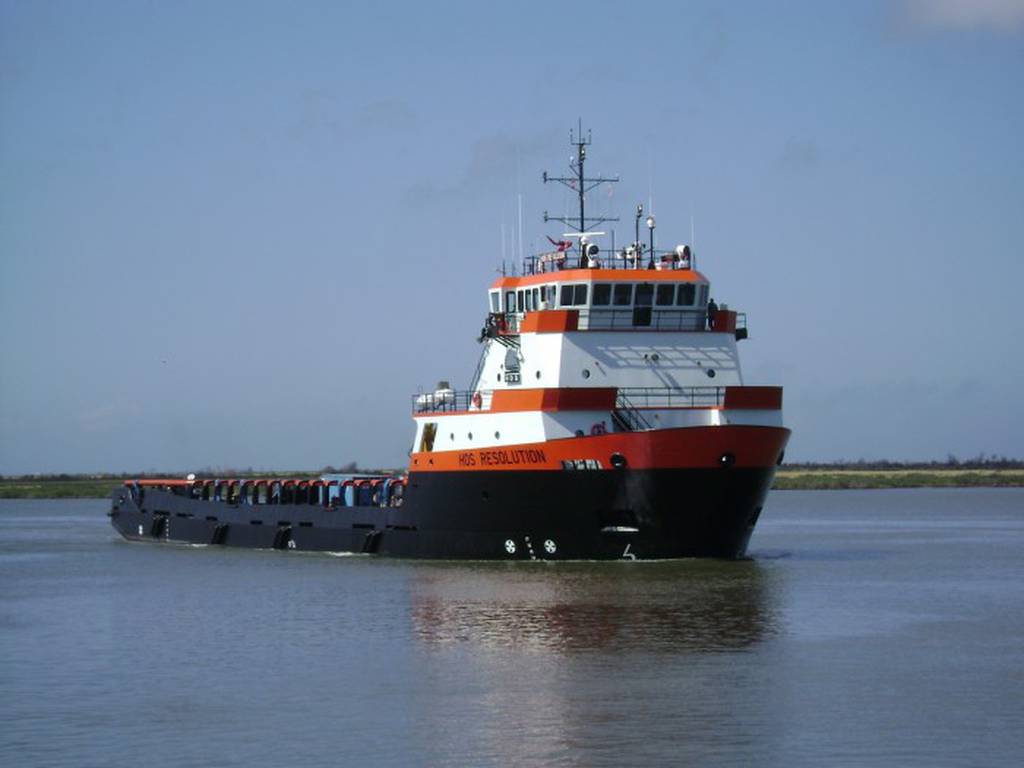
ARLINGTON, Va. — The U.S. Marine Corps has unveiled a four-phase test plan for its stern-landing vessel, the leased prototype that will help inform requirements for the Landing Ship Medium program and other future tools for Marines in the Pacific.
The service will accept delivery of the first leased stern-landing vessel and kick off the first phase of experimentation this month, Lt. Col. Tim Smith, the logistics combat element branch head at the Marine Corps Warfighting Lab’s science and technology division, told reporters last week.
This stern-landing vessel, or SLV, is an offshore support vessel from Hornbeck Offshore Services, which signed a contract to lease the ship to the Marine Corps and allow for significant modifications. To recreate the type of capability the force thinks it needs in its Landing Ship Medium, the Corps is adding to Hornbeck’s vessel a large ramp, a reinforced deck, landing legs, protection for the propellers and rudders, and more.
The Landing Ship Medium was formerly known as the Light Amphibious Warship, which included the ability to beach itself so Marine Corps vehicles and supplies can roll directly onto shore.
During this first phase of testing, “we’re going to find out how does the SLV actually work in some benign conditions” and gradually move into tougher surf conditions, Smith said.
“Do we have to use the jacking legs? What’s the impact to the beaches that we’re working? What is the impact of the ramp? Does it really do everything it says it’s going to do?” Smith added, noting the Marines would use the first 12 weeks to focus on the SLV’s fundamental performance.
The Corps will take nearly every vehicle in its inventory and move them on and off the beached SLV via the ramp, he said. And the team at the warfighting lab will write and repeatedly update manuals that govern how to use the vessel, he added.
The purpose of this first 12-week, limited technical analysis is to ensure that, when the vessel is turned over to operational forces, they can safely experiment with it.
This first phase will also inform the process for leasing additional SLVs. The Marine Corps has money to lease two more, Smith said, but has not begun seeking out potential vessels, which the service would likely receive for testing in 2024.
Based on the initial phase of testing with this first vessel, the service may find it doesn’t need the jacking legs and therefore wouldn’t pay to add them to subsequent prototypes, for example.
After the first 12 weeks of testing, the SLV will move to the second phase.
Once deemed safe, the vessel will be transferred to the warfighting lab’s experiments division, which will begin limited operations with the fleet, including the 3rd Marine Littoral Regiment.
The vessel will head to California and deeper into the U.S. Indo-Pacific Command theater for exercises and operations. Smith said the SLV would be heavily involved in future Marine littoral regiment experimentation, mobility and logistics assessments, as well as efforts to refine tactics and concepts of employment.
Smith said the SLV’s third phase would look at further uses for the vessel in the larger context of Navy-Marine Corps operations, and the fourth phase would look at joint force applications. “Does it play well with Army vehicles? Does it play well with potential Air Force use?” Smith said.
During these latter phases, additional capability gaps and ideas for future programs of record may emerge, leaders say.
Jeff Tomczac, the deputy director of the science and technology division at the warfighting lab, said the Marines are clear on their requirement for the Landing Ship Medium, which is needed to move people and equipment in the Pacific region. But this experimentation will also “define other gaps and shortfalls that we have not identified at this time that will eventually turn into future warfighting requirements, that will eventually turn into future programs of record,” he added.
Smith said this first SLV would carry regular gas and aviation gas, allowing it to potentially refuel surface craft like the Combat Rubber Raiding Craft and the Amphibious Combat Vehicle, or future underwater and aerial drones.
Smith also noted that the second or third leased SLV could receive modifications to feature a flight deck that enables vertical replenishments and ship-to-shore logistics supported by a rotary-wing drone.
Megan Eckstein is the naval warfare reporter at Defense News. She has covered military news since 2009, with a focus on U.S. Navy and Marine Corps operations, acquisition programs and budgets. She has reported from four geographic fleets and is happiest when she’s filing stories from a ship. Megan is a University of Maryland alumna.
- SEO Powered Content & PR Distribution. Get Amplified Today.
- Platoblockchain. Web3 Metaverse Intelligence. Knowledge Amplified. Access Here.
- Source: https://www.defensenews.com/training-sim/2023/03/08/us-marines-begin-four-phase-experiment-with-light-amphibious-surrogate/
- :is
- 1
- 10
- 11
- 2024
- 70
- a
- ability
- Accept
- acquisition
- actually
- added
- Additional
- AIR
- Air Force
- Allowing
- analysis
- and
- applications
- ARE
- Army
- AS
- assessments
- At
- aviation
- BE
- Beach
- Beaches
- begin
- Branch
- Budgets
- by
- california
- CAN
- carry
- clear
- combat
- concepts
- conditions
- context
- contract
- could
- covered
- craft
- create
- deeper
- Defense
- delivery
- deputy
- directly
- Director
- Division
- Doesn’t
- drone
- Drones
- element
- enables
- ensure
- equipment
- eventually
- Every
- everything
- example
- experiment
- Feature
- Filing
- Find
- First
- FLEET
- flight
- Focus
- For
- Force
- Forces
- formerly
- Fourth
- from
- fundamental
- further
- future
- GAS
- geographic
- going
- gradually
- Have
- head
- heavily
- help
- How
- How To
- HTTPS
- ideas
- identified
- image
- images
- Impact
- in
- included
- Including
- initial
- inventory
- involved
- IT
- ITS
- itself
- joint
- jpg
- kick
- known
- lab
- landing
- large
- larger
- Last
- leaders
- leasing
- legs
- light
- like
- likely
- Limited
- logistics
- Look
- Marine
- Maryland
- medium
- Megan
- Military
- mobility
- Modifications
- modified
- money
- Month
- more
- move
- nearly
- Need
- needed
- needs
- news
- noted
- of
- on
- operational
- Operations
- Other
- Pacific
- Pay
- People
- performance
- phase
- plan
- plato
- Plato Data Intelligence
- PlatoData
- Play
- potential
- potentially
- process
- Program
- Programs
- protection
- prototype
- prototypes
- purpose
- Ramp
- receive
- record
- region
- regular
- REPEATEDLY
- Reported
- reporter
- requirement
- Requirements
- Roll
- rubber
- s
- safe
- safely
- Said
- says
- Science
- Science and Technology
- Second
- seeking
- service
- Services
- signed
- significant
- since
- So
- some
- Stories
- subsequent
- support
- Supported
- surf
- Surface
- tactics
- Take
- team
- Technical
- Technical Analysis
- Technology
- test
- Testing
- that
- The
- their
- Them
- therefore
- These
- Thinks
- Third
- Tim
- time
- to
- tools
- transferred
- TURN
- Turned
- u.s.
- U.S. Navy
- underwater
- university
- University of Maryland
- unveiled
- Update
- us
- use
- vehicle
- Vehicles
- Vessel
- via
- week
- Weeks
- WELL
- What
- What is
- which
- will
- with
- Work
- working
- would
- write
- zephyrnet

